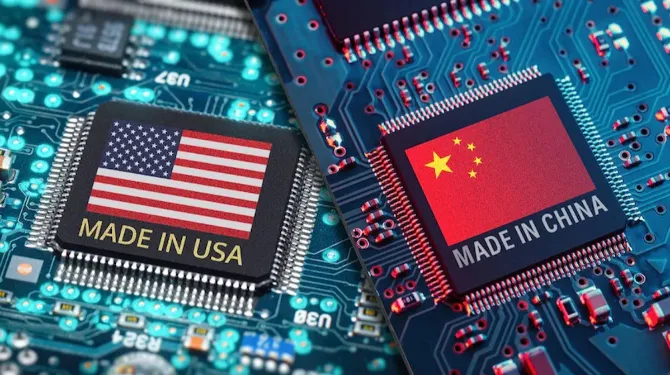
The ‘chip war’ between the United States (US) and China has become an integral part of the structural dynamics in their competitive relationship. As the Biden administration seeks to regulate Artificial Intelligence (AI), manage data, and secure a technological advantage over China while preventing bilateral tensions from escalating, the chip regulations imposed by the Biden administration against China have emerged as a focal point in the competitiveness of the two nations.
The ‘chip war’ between the United States (US) and China has become an integral part of the structural dynamics in their competitive relationship.
In recent years, the geopolitics of chips and the regulations governing their trade have centred around technology transfer; this is particularly evident in the US-China relationship. On the global stage, nations have rapidly enhanced their capabilities to process, store, and collect data, primarily through advanced chip manufacturing and restructured alliances to ensure predictability. Both domestic and external initiatives predating the Biden administration in the US aimed at gaining an advantage over China. The Trump administration's initial move in this direction was the executive order halting the takeover of one of the US' major chip manufacturers, Qualcomm, by the Singapore-based Broadcom. This action became absorbed into the broader ‘trade war’ with China.
With the advent of a Democratic presidency in the US under Biden, expectations for cooperation between the US and China emerged. However, these hopes were dashed by subsequent assertive measures taken by Biden, such as the landmark decision on 7 October 2022, curbing the export control of semiconductors to China, and the Chips and Science Act of 9 August 2023, regulating US investments in the Chinese semiconductor industry, citing it as a ‘state of emergency.’
The 2022-2023 period has witnessed strong legislative interventions from the Biden administration to maintain the US’ dominance in chip manufacturing and related supply chains. America invented the semiconductor, but today produces only about 10 percent of the world’s supplies. The US Department of Commerce's curbs are aimed at limiting the export control of Chinese manufacturing of advanced computing chips, supercomputers, and advanced semiconductors. Some of the export controls are aimed at new license requirements for items to be used in supercomputers as well as the production of chip manufacturing equipment which can otherwise benefit China. Some of these high-end technologies include “logic chips with nonplanar transistor architectures, or with a production technology node of 16–14 nanometers or below, dynamic random-access memory (DRAM) chips of 18-nanometer (nm) half-pitch or less; or NAND flash memory chips with 128 layers or more.” As a broad rule, the smaller the size of the chip, the more advanced its capacity. The recent breakthrough by Huawei which claims to have indigenously developed 7nm chips may be as much of a pointer towards limitations of US restrictions, as to the fractures in the global supply chains and possible disruptions.
Chinese calls for developing a domestic ecosystem to shun external reliance on new and emerging technologies have made the US more cautious. Biden’s executive order of August 2023 sought to restrict US investments in Chinese entities in three sectors: semiconductors and microelectronics, quantum information technologies, and certain artificial intelligence systems. For the first time, the US limited exchanges of not just people and products, but capital as well. Through the latest executive order in October this year, the Biden administration took another step towards tech and data control, requiring new safety assessments, equity and civil rights guidance and research on AI’s impact on the labour market.
Chinese calls for developing a domestic ecosystem to shun external reliance on new and emerging technologies have made the US more cautious.
As a dominant economic and tech power, Beijing has also taken countermeasures against the US. China has imposed additional limits on the export of two critical semiconductor components—germanium and gallium. Additionally, China has outlawed the sale of American Micron chips to Chinese companies. On 20 October, China imposed fresh export limits on specific graphite products in reaction to the expanded US regulations. In both instances, China retaliated against the broader economic security measures by the West by using its control over the world's vital raw material and mineral supply chains. Around 60 percent of the world's germanium and 90 percent of the world's gallium are produced in China. Since graphite is a crucial component of electric vehicle (EV) batteries, China's graphite controls are expected to be more impactful in the EV battery production industry. A major risk in this economic-security escalation is that China’s controls on raw materials could seriously disrupt the ability to produce critical, emerging, and green technologies. For China, these advantages can produce greater economic and geopolitical bycatch as its net expands, potentially impacting a host of other critical sectors for the US and allied supply chains.
A major risk in this economic-security escalation is that China’s controls on raw materials could seriously disrupt the ability to produce critical, emerging, and green technologies.
The export control restrictions of 7th October 2022—one of the primary steps in the US-China chip rivalry—have had two main effects on the US industry: a reduction in Chinese market demand for cutting-edge chips and related technologies and retaliatory controls and sanctions by China augmenting geopolitical competition. According to PitchBook data, the total amount of venture capital investment from the US into China fell to US$9.7 billion from US$32.9 billion in 2021. Only US$1.2 billion has been invested in Chinese tech start-ups by US venture capitalists thus far in 2023. One-third of US semiconductor companies' revenue comes from sales to China; for some companies, that number may be as high as 70 percent. The US could hurt its own semiconductor companies and leave gaps for foreign competitors including China if it moves too slowly in establishing supply chain networks in the Indo-Pacific. The existing export restrictions on chips and semiconductor equipment diminish the potential market size for US companies, which could potentially undermine America's competitive advantage in the mid-to-long-term. China is not the only source of imports into the US, although it does make up the largest share of imports at 33 percent. Also, Beijing may not get the desired results from its export restrictions on germanium and gallium due to China's own smuggling issues and the importers' resolve to reduce their reliance.
The ‘chip war’ appears to be falling short of its intended objectives. In an era characterised by complex interdependence, the effectiveness of sanctions and export controls in achieving desired outcomes may be compromised by the diffusion of technological capabilities among both allies and adversaries. This challenge may be particularly pronounced for the US, given its extensive network of partners, friends, and allies. The evolving semiconductor industry holds significant potential to influence defence, especially as semiconductor chips can be utilized for dual purposes, making their integration with AI a matter of concern.
As we embark on a new digital era, the struggle for possession, innovation, and control of technologies within societies and among nations will shape the landscape of great power politics. Technological advancements have historically been a driving force behind shifts in the global power structure. In the 19th century, Britain led the industrial revolution, while the competition between the US and the erstwhile USSR over the control and innovation of space, nuclear, and other crucial technologies defined the power dynamics of the latter half of the 20th century. The rivalry in the field of semiconductors is poised to echo these transformative periods of competitiveness.
What distinguishes the semiconductor race is the widespread application of its technology across various sectors, ranging from remote control to AI, and from agriculture to aviation. Cantelmo and Creps suggest the possibility of a shift in the grand strategy of superpowers due to advances in computing power and robotics. Consequently, viewing the US-China competition for dominance in the chip race solely through an economic lens or as a trade war would be short-sighted. This competition will likely have a profound impact on numerous other sectors critical to the great power politics of this era.
Vivek Mishra is a Fellow with the Strategic Studies Programme at the Observer Research Foundation.
Pankaj Fanase is a research intern at the Observer Research Foundation.
The views expressed above belong to the author(s). ORF research and analyses now available on Telegram! Click here to access our curated content — blogs, longforms and interviews.




 PREV
PREV



